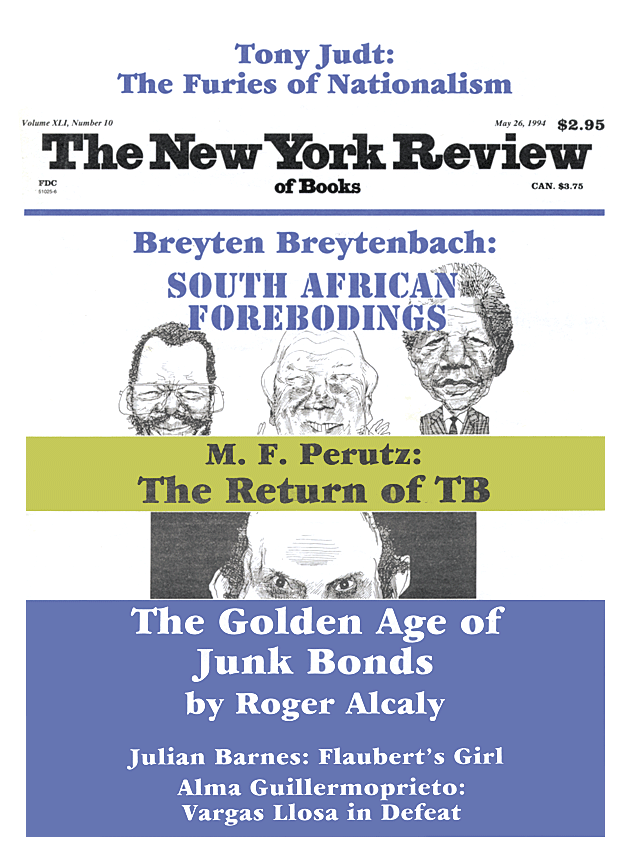In response to:
Worth a Detour from the March 24, 1994 issue
To the Editors:
I enjoyed Tim Parks’ review essay (Joseph Cary’s Ghost in Trieste, NYR March 24). I agree with him that Umberto Saba’s poetry is exceedingly difficult to translate, and thank him for his acknowledgment of my translation of Saba’s prose.
I agree with Parks too, that “the creative isolation” which Trieste provided Saba, Italo Svevo and James Joyce, enabled these writers to produce masterworks there. However, his observation that “for Joyce the most important thing about Trieste was surely that it was not Dublin,” is not precise. Certainly, Joyce had to flee Dublin, and his arrival in Trieste was fortuitous. But Trieste not only had the negative virtue of not being Dublin. Joyce remained there for eleven years, precisely because there was much about the city that was very much like Dublin. An Austrian city with an Italian heart, irredentism was a powerful political and emotional force throughout Trieste, particularly among its artists and writers. As I note in an unpublished essay, Joyce often harangued Svevo and other of his Italian friends on the similarity between their political situation as Triestinos, and his, as an Irishman. In addition, there was something about the size and nature of Trieste with its bustling commerce yet provincial air, that made it comfortably Dublin-like to Joyce. Visiting Trieste’s cafes, theaters, going to the opera, Joyce found to his pleasure, that he would recognize people, and be recognized, just as in the city of his birth.
Parks also writes that Svevo “hardly ever mention(s) or describe(s)” Trieste in his novels. Not so. Or perhaps this too, is a matter of precision (what Parks means by “hardly”). Trieste is an eminently “walkable” city, and a 1990 literary walk-book entitled Trieste, is subtitled, “Addio bigliardo, addio passeggiate” (“Farewell billiards, farewell long walks,” a remark made by Stefano Balli, the protagonist of Svevo’s Senilità). Elena Vitas, author of the book, observes in her preface that characters in the great literature set in Trieste are always, as their creators did, taking long walks; hurrying from someone’s house to someone else’s, from one cafe to another, from the theater to the library, from the wharves to the shops. Pages seventy-seven to eighty-seven of Trieste are devoted exclusively to Svevo’s works. With Vitas’ book in hand one can read what Svevo (or his characters) said about a particular place in the city, find it on the accompanying map, or better still, go out, as Trieste buffs do, and take the walk oneself.
As Joseph Cary discovered, there’s no lack of ghosts in Trieste.
Estelle Gilson
New York City
Tim Parks replies:
People do indeed walk a great deal in Svevo’s novels as in so many novels prior to the invasion of the motorcar (and in some afterward). My point was merely that Trieste never becomes the subject of Svevo’s work, or even a major player. As for Joyce, comments in unpublished essays on his “often haranguing Svevo” can be taken with a pinch of salt. Apart from brief flirtations with Irish nationalism in early adulthood, Joyce never became seriously engaged in politics. Any reading of the circumstances of his life makes it clear that the most important thing about Trieste was that his brother Stanislaw was there to make sure he didn’t starve. The idea that superficial similarities between Trieste and Dublin could have weighed seriously in the balance as he stumbled from one debt to another is fanciful. But what is most curious to me, both in Joseph Carey’s book and again in Estelle Gilson’s letter, is the evident desire to attach romance to place, to imagine that because Svevo says that Zeno walks from A to B (without bothering us as a rule with any description) we might profit from taking that walk ourselves. But perhaps I just have difficulty with the word “ghosts.”
This Issue
May 26, 1994


